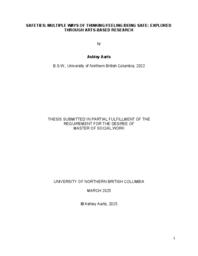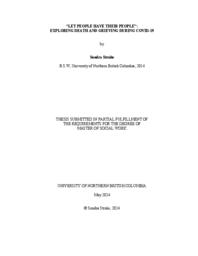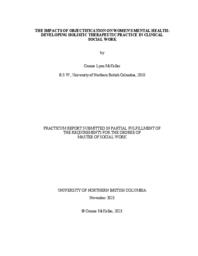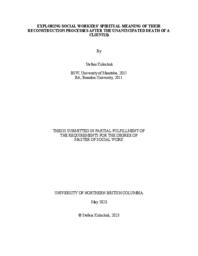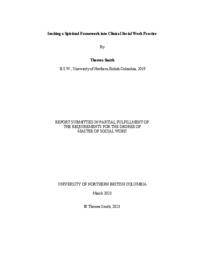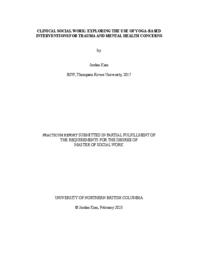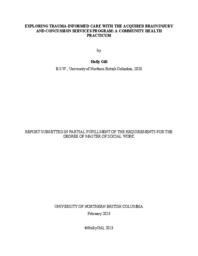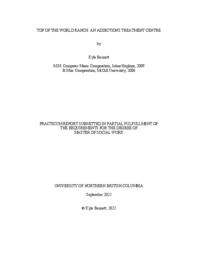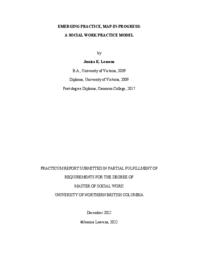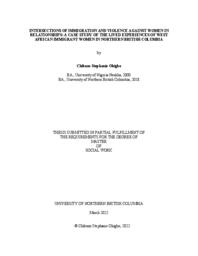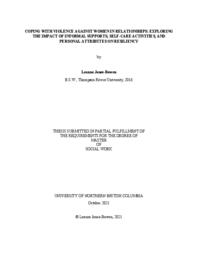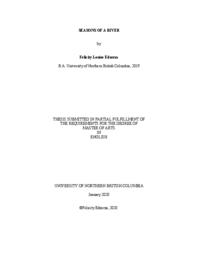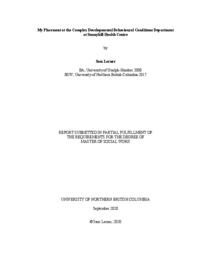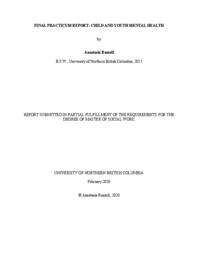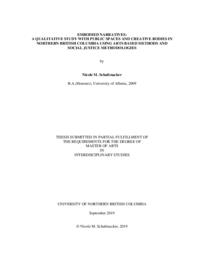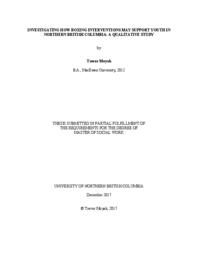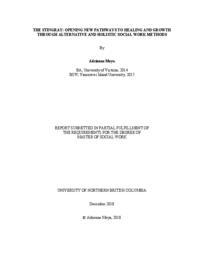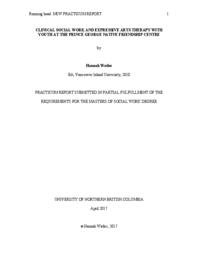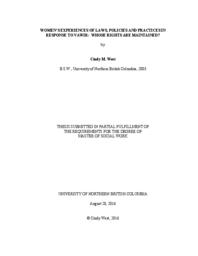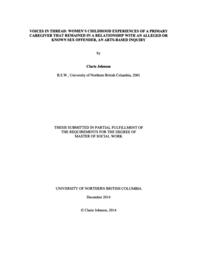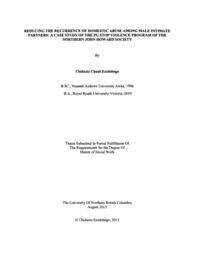Margolin, Indrani
Person Preferred Name
Indrani Margolin
Related Works
Content type
Digital Document
Origin Information
Content type
Digital Document
Origin Information
Content type
Digital Document
Description / Synopsis
no abstract available
Origin Information
Content type
Digital Document
Description / Synopsis
Background: This interpretive qualitative inquiry explores the spiritual meaning of their reconstruction processes of social workers after the unanticipated death of a client. Identifying existing social networks and using snowball sampling, ten social workers in British Columbia were recruited for this research. From a socially constructed and spiritual perspective, the researcher examines this process in collaboration with the ten participants. Through semistructured interviews the social work participants gave deep and rich personal stories reflecting on the experience of having a client unexpectedly die. Through a process of thematic analysis, four main themes, and nine sub-themes emerged from the data. Objective: To explore and gain a better understanding of social workers’ experiences of unanticipated client death and the spiritual meaning of their reconstruction processes after this experience. Methods: An interpretive qualitative inquiry was used for this study. A literature review was conducted to identity existing research and any gaps in research on the thesis question. Subsequently, semi-structured interviews were conducted with ten social worker participants who shared their experiences of unanticipated client death and spiritual meaning of their reconstruction processes. Thematic analysis of the data, guided by Braun and Clark (2018) was undertaken. Results: Three main themes and eight subthemes about how social workers experience and process the death of a client were found. Results revealed social workers often experience multiple client deaths that can be traumatic and have long lasting impacts/memories and that making sense of this experience is generally complex, unique to the individual, and meaning was found to be tied to systemic issues in the context of client death. A comparative analysis of Indigenous and non-Indigenous agencies in relation to spiritual supports are also presented. Conclusion: The experience of having a client death(s) is impactful and was found to be generally traumatic for social workers. Spirituality may play a part in how this experience is processed and understood. Systemic issues and current neoliberal systems were reported to be main factors in how death was understood in the context of worker-client relationship. Informal support in the workplace was perceived as essential and formal workplace supports were seen as ingenuine and challenging to access. Spiritual and culturally based supports naturally found within Indigenous culture were perceived as a welcome support, especially in the context of client bereavement. Finally, through this inquiry it was apparent there needs to be more research about the understudied impacts of experiencing the unanticipated death of a client, how social workers perceive, and access formal workplace supports, and how individual social workers and organizations draw from and utilize spirituality in social work practice.
Origin Information
Content type
Digital Document
Origin Information
Content type
Digital Document
Description / Synopsis
My practicum placement took place at Cottonwood Creek Wellness in Nelson, British Columbia where I began working alongside my practicum supervisor, Catherine Williams, who provides therapeutic support to families, children, and youth. Her services include offering specialized counselling in the areas of Attachment, working with parents, Family Therapy, Infant Mental Health, and assessment and treatment of all forms of Anxiety. My objective within my practicum was to practice from a holistic and trauma-informed perspective and to gain an understanding of how alternative therapies, such as yoga-based interventions can be incorporated into clinical social work practice. Not only did my experience as an MSW student provide me amples of opportunities to explore how to use complementary treatment modalities with clients, but it also allowed me to witness their efficacy when integrated into the therapeutic process in a purposeful, open, and creative manner.
Origin Information
Content type
Digital Document
Description / Synopsis
This report focuses on what I learned about trauma and acquired brain injuries during my Master of Social Work (MSW) practicum at Acquired Brain Injury and Concussion Services with Fraser Health Authority (FHA) located in Langley, British Columbia. This in-depth and unique practicum allowed me to practice independently as a MSW student and utilize my clinical practice skills. In addition to highlighting the role of social workers within interdisciplinary teams and delivering services within the healthcare system. The practicum provided the opportunity to explore the experiences of practicing social work within community health settings and compare my experiences to acute social work.
Origin Information
Content type
Digital Document
Description / Synopsis
Mental Health affects one in five people in Canada (Statistics Canada, 2022), many of whom will seek treatment at a residential center with support for those recovering from addiction. This paper presents my Graduate Practicum Report completed at an Addictions treatment center, the Top of the World Ranch (TWR), located in the East Kootenays of British Columbia. The practicum was focused on addictions, mental health, and counselling modalities as they apply to the context of addiction, with the goal of applying skills and modalities studied in the course work of my MSW preceding this final practicum. After reviewing mainstream and holistic modalities like Cognitive Behavioural Therapy (CBT), Dialectical Behavioural Therapy (DBT), shinrin yoku, visualization, and meditation, I assembled a strong set of tools to offer value at an addiction treatment center with a focus on trauma informed practice. Key learnings in this report include the usage of art therapy and visualization as effective tools in recovery from addiction. I also found a meaningful way to integrate music into my personal therapeutic approach. Additionally, I found programs that involved visualization and meditation to be both an enjoyable way of working and extraordinarily helpful for clients’ recovery process. My practicum at the TWR was one of the most important learning experiences of my life that will inform all that I do moving forward in my career as a counsellor and social worker.
Origin Information
Content type
Digital Document
Description / Synopsis
As social workers, we develop our own integrated social work theory and practice model to guide an ethical, accountable, and evidence-based approach to professional practice. This report describes my emerging model, a map-in-progress, developed over the course of my Master of Social Work degree and final practicum. My practice takes place in the territories of the Tla’amin Nation. In this report, I focus on social work in primary health care, grounded in a theoretical orientation of Just Practice, queer theory, and abolitionist theory. I describe four landmarks generated in the context of my practicum: i) interprofessional practice, ii) the clientpractitioner relational continuum, iii) equity-oriented health care, and iv) abolitionist social work. I present a series of process-oriented collages rooted in the tradition of arts-based inquiry as selfreflexive practice. This report serves as a tangible touchstone for my emerging practice and I offer it as a humble addition to social work scholarship and practice.
Origin Information
Content type
Digital Document
Description / Synopsis
This research is for the researcher’s graduate thesis, as a requirement to obtain a Master of Social Work degree. The thesis research was conducted via distance (using telephone and password-protected audio conferencing) with four immigrant women. Using a case study approach and framed by socialist feminist intersectional theories and transformative framework, this thesis examines the intersections of immigration and violence against women in relationships (VAWIR) on multiple axis including gender, race, class, immigrant, and economic status to better understand factors that shape the experiences of visible minority immigrant women dealing with domestic violence and abuse. The findings of this thesis would contribute to different viewpoints on the experiences of VAWIR among immigrant women and bring more understanding to a variety of ways immigrant women respond to and cope with violence in their relationships as well as shape future policies and practices to more effectively service immigrant women of African descent.
Origin Information
Content type
Digital Document
Description / Synopsis
This thesis was conducted in the province of Alberta’s Edmonton Metropolitan Region (EMR) to identify the themes and variances among women’s informal methods of coping with and leaving abusive relationships, using a qualitative-exploratory approach. With the acknowledgment of feminist theory, the strengths-based perspective, and person-centred theory, this thesis explored women’s perspectives and their personal experiences of resiliency during and after leaving their abusive, male partners. Thematic analysis was used to code and analyze the data, which identified the following themes among the survivors: strong, informal support networks, engaging in self-care activities and self-improvement activities as a trauma response, and, the shared, personal attributes of self-preservation, resourcefulness, and self-reflection. Recommendations for theory, practice and further research are posed to the helping professions and informal support networks of survivors.
Origin Information
Content type
Digital Document
Description / Synopsis
In this thesis I draw on deconstruction theory and queer theory to analyze the current representation of sex, gender, and sexuality in Canadian television. Through this research I found that although Canadian television is portraying an increasing number of queer genders and sexualities, misinformation and stereotypes continue to perpetuate a one-dimensional characterization of people. This research pertains directly to my creative thesis: a pilot episode of a TV series which fraternal twins, Jed and Theodora, grow up with the ability to switch into one another's body. I dive directly into the correlation between sex and gender and the lived experience of being in a body that does not necessarily represent gender. The will both create a new gendered "construction" as well as question the need for gender identifications.
Origin Information
Content type
Digital Document
Description / Synopsis
Seasons of a River is a fictional story about a woman looking back on her life. In her recollections she has to acknowledge and come to terms with the fact that her relationships with indigenous people in Canada have been inequitable and unbalanced. She realizes that she has been in the role of helper, of ally, and as such has perpetuated ideas of colonization and oppression, despite her good intentions. The protagonist, Annan, is in the process of trying to understand the complicated issues involved with the helping industry and her part within that industry. My introduction discusses the power differentials within allyship relations. I discuss how liberalism, at the root of the helping industry, although seen as a positive ideology, often perpetuates inequities and injustices when dealing with groups that are seen as “different.” I also discuss the importance of relationship building and listening and the need for quelling the tendency to assist others without consultation. This introduction and story also contain themes of ageism and how these attitudes are woven into the fabric of society in such a way as to internalize oppression and the idea of staying in one’s “place.” Ultimately, this story is about transformation.
Origin Information
Content type
Digital Document
Description / Synopsis
My practicum at the Sunnyhill Complex Developmental and Behavioural Conditions Department has taught me about the role of Social Work within an interdisciplinary team in a medical setting, and the value of aligning with the needs and strengths of families and caregivers. This practicum has also informed me on the function of a diagnosis in determining community supports. My preparatory research included youth with developmental disabilities, the assessment process, the need for more significant structural support, the life-needs model, the portage model, how to support families and caregivers, social work within an interdisciplinary team, mindfulness and outcome evaluations. My learning experience has implications for my future practice working within interdisciplinary teams. In my future work, I aspire to promote social justice and ethical practice by using my skills and expertise of external and community resources to overcome barriers in culturally sensitivity ways that honours the client’s unique strengths, needs, and their selfdetermination. My experience and learning enriched my professional capacity and my appreciation of the value of Social Work in supporting families and individuals.
Origin Information
Content type
Digital Document
Description / Synopsis
Through my practicum, I explored the role of a child and youth mental health clinician (CYMH) while also expanding and adapting my clinical skills and therapeutic modalities. Early childhood development and trauma have shown to have tremendous influence over the onset of future mental health concerns, while epigenetics and biology also play a key role in the development of potential neurological disorders. Cognitive Behavioral Therapy (CBT), Mindfulness and Expressive Arts Therapy were investigated within the realm of mental health. These modalities are actively used as therapeutic tools within CYMH. This practicum report expands on the role of trauma within mental health, exploring holistic approaches such as Expressive Arts Therapy and meditation in concurrence with CBT and MBSR to facilitate deeper understanding of a person’s narrative through their own creative and subjective experience. While pharmacology helps keep symptomology at a baseline, it is the coping and regulation tools that are needed to help a person navigate their own internal processes and stress modulation in order to achieve post-traumatic growth.
Origin Information
Content type
Digital Document
Description / Synopsis
This multidisciplinary arts-based research-creation study explored health and wellness realities, including my own, of people in northern British Columbia. In two public settings, autoethnographic creative writing was translated into installations and performances. The use of arts-based methods in this study was intended to evoke participants’ intuitive ways of knowing, leading to (re)connection with self, body, and land/place: in short, to resilience. The broadest question of the research was: Can practices anchored in creative/performative autoethnography and body-attuned narrative help people in northern landscapes attend to mental health and healing? The findings emphasized achievable potentials for individual and community resilience, as well as renewed connection to place, through creative interventions that engage narrative in sensorial ways. Findings also emphasized the importance of selfdetermination and agency within the design of creative interventions, and the implications for healing through witnessing narrative.
Origin Information
Content type
Digital Document
Origin Information
Content type
Digital Document
Origin Information
Content type
Digital Document
Origin Information
Content type
Digital Document
Origin Information
Content type
Digital Document
Origin Information
Content type
Digital Document
Origin Information
Content type
Digital Document
Origin Information

